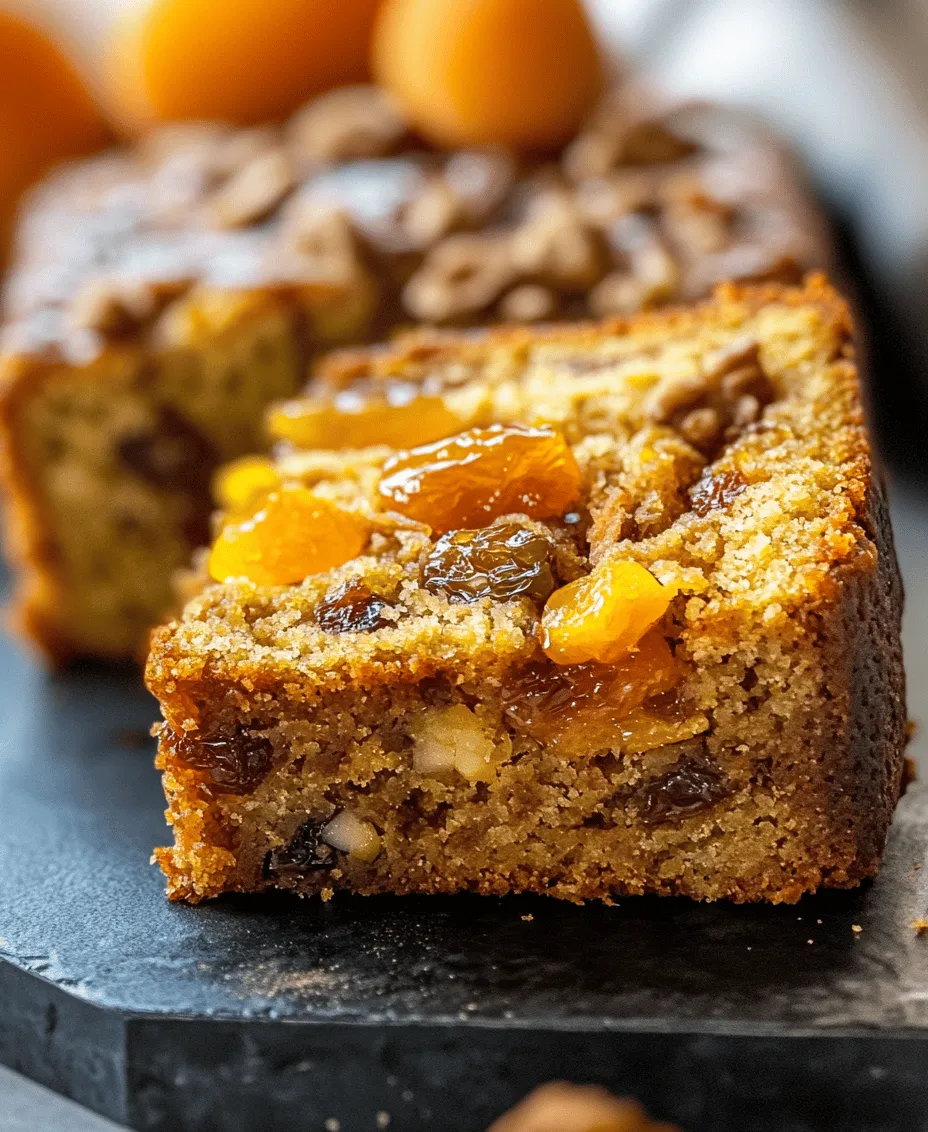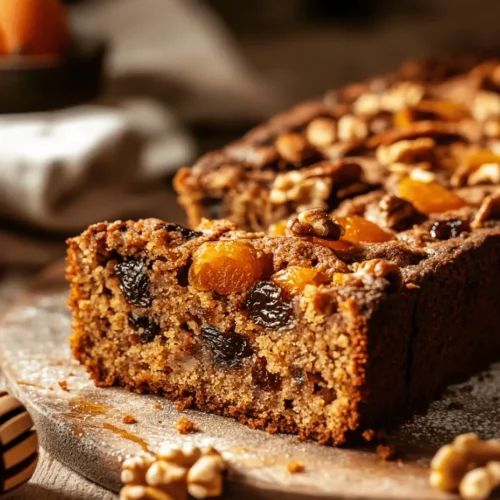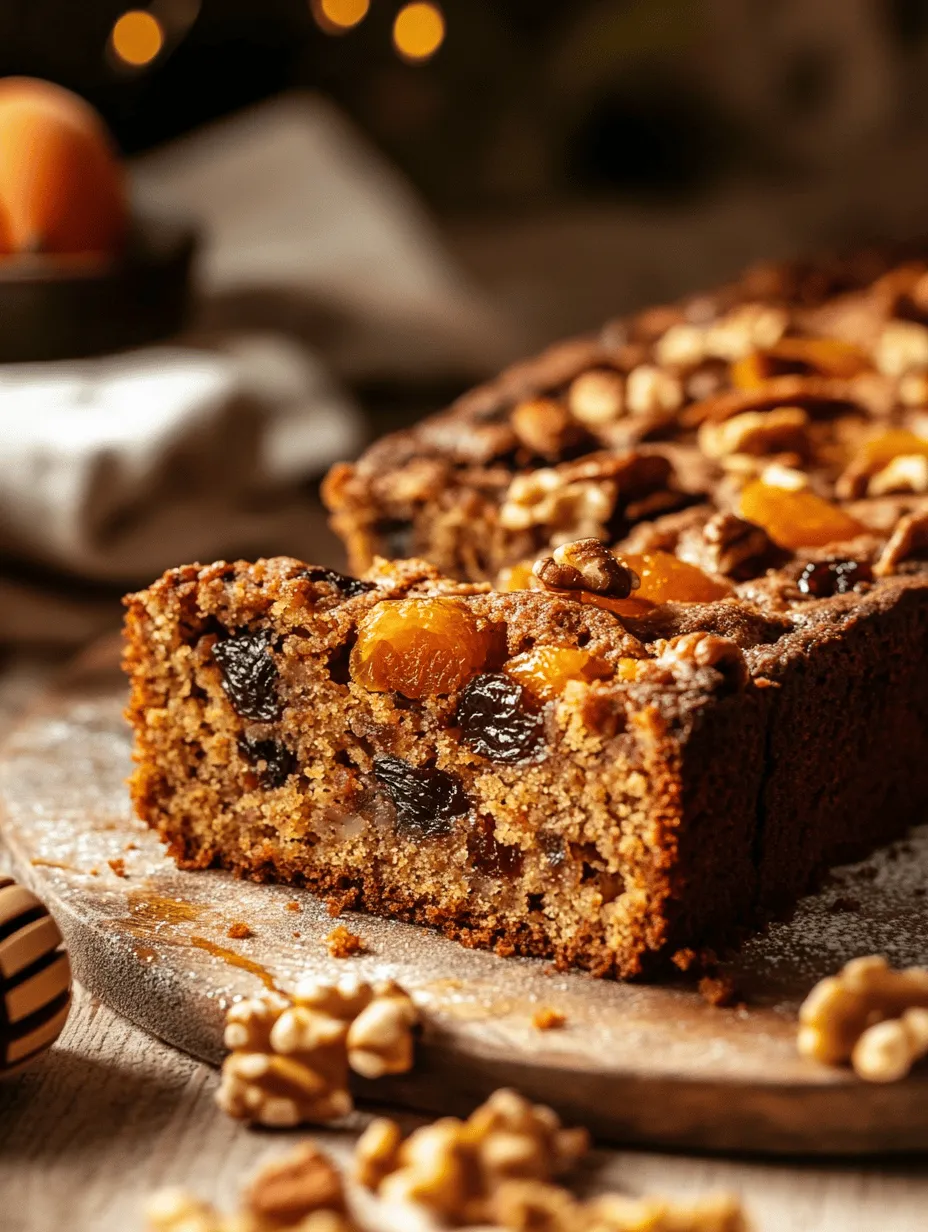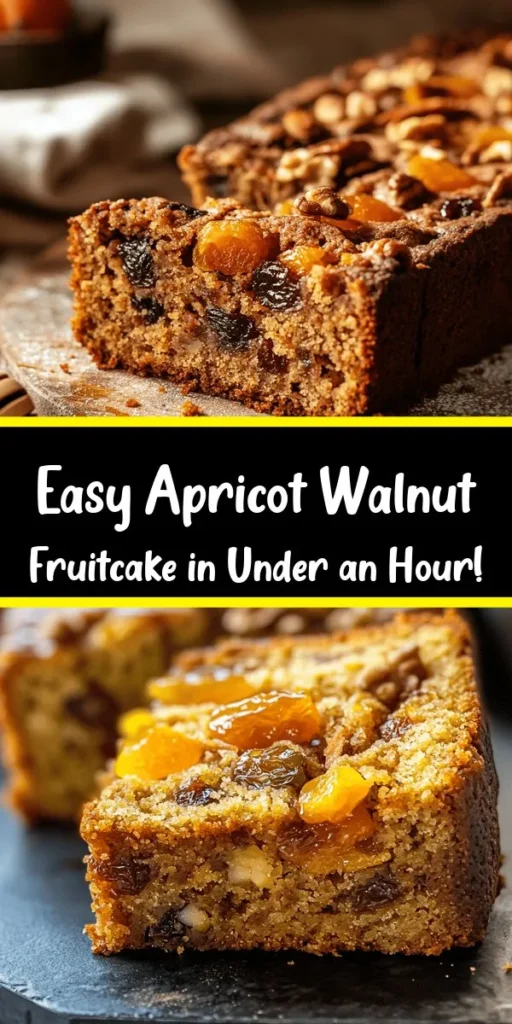Introduction
When it comes to baking, few treats evoke nostalgia and warmth quite like a fruitcake. Traditionally associated with festive occasions, fruitcakes have a rich history across various cultures, often serving as a symbol of celebration and abundance. However, many people shy away from making fruitcakes due to misconceptions about their preparation complexity. Our Quick & Easy Apricot and Walnut Fruitcake dispels these myths, proving that a delicious, moist fruitcake can be both simple and satisfying.
This unique recipe highlights the delightful combination of sweet, tangy dried apricots and crunchy walnuts, offering a fresh twist on the classic fruitcake. The vibrant flavor profile of apricots adds a fruity brightness, while walnuts contribute a satisfying crunch and earthy richness. Perfect for holiday gatherings, afternoon tea, or simply as a snack, this fruitcake is not only appealing but is also a health-conscious choice, thanks to the nutritious ingredients that enhance its flavor and texture.
Understanding the Ingredients
To create a truly exceptional fruitcake, it’s essential to understand the role each ingredient plays in the final product. Below, we break down the key components of our Quick & Easy Apricot and Walnut Fruitcake, highlighting their unique contributions and benefits.
Dried Apricots
Dried apricots are a star ingredient in this fruitcake, providing a natural sweetness and a burst of color. Their flavor is a delightful balance of tangy and sweet, which complements the richness of the walnuts beautifully. Beyond taste, dried apricots are packed with nutrients; they are an excellent source of vitamins A and C, potassium, and dietary fiber. These health benefits make them a smart addition to any recipe, allowing you to indulge in a treat that offers nourishing qualities as well.
Walnuts
Walnuts bring a distinctive crunch and depth of flavor to our fruitcake. These nuts are not only delicious but also highly nutritious; they are rich in omega-3 fatty acids, antioxidants, and several vitamins and minerals. Walnuts contribute to heart health and may improve brain function, making them an excellent choice for a wholesome dessert. The texture they provide adds to the overall mouthfeel of the cake, creating a delightful contrast to the tender crumb.
All-Purpose Flour
At the foundation of any baked good, all-purpose flour plays a crucial role in providing structure to our fruitcake. It acts as the base for the cake and helps to create the necessary gluten that gives the cake its form. The quality of the flour can significantly affect the texture, so opting for a reliable brand is always a good idea.
Baking Powder and Baking Soda
Leavening agents such as baking powder and baking soda are vital for achieving the perfect rise in our fruitcake. They create tiny air bubbles that expand during baking, resulting in a light and airy texture. Using the right amount of these agents ensures that your cake rises correctly and has a tender crumb.
Ground Cinnamon
To elevate the flavor profile of the fruitcake, we include ground cinnamon. This warm spice not only enhances the overall aroma but also adds depth to the cake’s flavor. Cinnamon is known for its anti-inflammatory properties and can even help regulate blood sugar levels, making it a flavorful and health-conscious choice.
Buttermilk
Buttermilk is a key ingredient in our recipe that adds moisture and richness to the cake. Its acidity helps to tenderize the gluten in the flour, resulting in a softer texture. Additionally, buttermilk enhances the flavor, giving the cake a subtle tang that pairs perfectly with the sweetness of the apricots and the nuttiness of the walnuts.
Optional Honey
While the recipe includes naturally sweet dried apricots, you may choose to add honey for an additional layer of sweetness. Honey not only enhances flavor but also brings its own set of health benefits, including antimicrobial properties and antioxidants. If you prefer a less sweet cake, you can easily omit the honey or replace it with a sugar alternative that fits your dietary needs.
Preparation Steps in Detail
Now that we’ve covered the essential ingredients, let’s dive into the preparation steps for our Quick & Easy Apricot and Walnut Fruitcake. Follow this detailed guide for a seamless baking experience.
Step 1: Preheating the Oven
The first step in any baking endeavor is to preheat your oven. This step is crucial as it ensures that your cake begins baking at the right temperature, allowing for optimal rising and cooking. Preheat your oven to 350°F (175°C) before you start mixing the ingredients to save time and ensure your cake bakes evenly.
Step 2: Preparing Fruits and Nuts
Before you start combining ingredients, it’s important to prepare the dried apricots and walnuts. Chop the apricots into small pieces to ensure they distribute evenly throughout the cake. For the walnuts, you can either chop or leave them whole, depending on your texture preference. After chopping, toss the fruits and nuts in a small amount of flour (about a tablespoon) to prevent them from sinking to the bottom of the cake during baking. This simple technique helps to ensure that your cake is filled with delightful bites of apricot and walnut in every slice.
Step 3: Mixing Dry Ingredients
In a separate bowl, combine the all-purpose flour, baking powder, baking soda, and ground cinnamon. Whisk these dry ingredients together until they are thoroughly mixed. This step is essential for ensuring that the leavening agents are evenly distributed throughout the flour, which contributes to an even rise.
Step 4: Creaming Butter and Sugar
In a large mixing bowl, cream together softened butter and sugar using an electric mixer on medium speed. This process usually takes about 3-5 minutes. Creaming incorporates air into the mixture, which is essential for achieving a light and fluffy texture in your cake. You want to aim for a pale, fluffy mixture that has increased in volume.
Step 5: The Egg-Adding Technique
Once your butter and sugar are well creamed, it’s time to add the eggs. Crack the eggs into a small bowl to ensure there are no shells, and then add them one at a time to the creamed mixture. Beat well after each addition to fully incorporate the eggs. This step is critical for balancing moisture and structure in your fruitcake, as eggs provide both binding and leavening properties.
Step 6: Incorporating Buttermilk
Finally, add the buttermilk to the egg and butter mixture. Mix on low speed just until combined. The buttermilk will contribute to the moisture of the cake, ensuring that it remains tender and delicious. Be careful not to overmix at this stage, as it can lead to a denser texture.
With these steps completed, you’re well on your way to creating a delectable Quick & Easy Apricot and Walnut Fruitcake. The next part of the process will involve combining the wet and dry ingredients, followed by baking. Stay tuned for the continuation of this delightful recipe, where we will guide you through the final steps to achieve the perfect fruitcake!

Folding in Fruits and Nuts: Maintaining the Batter’s Integrity
Once your fruitcake batter is well-mixed, it’s time to fold in the star ingredients: the apricots and walnuts. This step is crucial, as it helps distribute the fruits and nuts evenly throughout the batter while maintaining its light and airy texture. Begin by gently adding the chopped apricots and walnuts to the batter. Using a rubber spatula, employ a gentle folding technique. This involves scooping from the bottom of the bowl and lifting the batter over the fruits and nuts without stirring vigorously. This method keeps the batter intact and prevents it from becoming dense, ensuring a light and fluffy cake once baked.
Baking Tips: Recognizing Doneness and Avoiding Overbaking
Baking the perfect fruitcake requires attention to detail, particularly when it comes to recognizing doneness. As the cake bakes, it will rise beautifully and develop a lovely golden-brown color. To check for doneness, insert a toothpick or skewer into the center of the cake. If it comes out clean or with a few moist crumbs attached, the cake is ready. However, if the toothpick is covered in wet batter, it needs more time in the oven.
Avoiding overbaking is equally important, as it can lead to a dry fruitcake. Keep an eye on the baking time, and start checking for doneness a few minutes before the recommended baking time is up. Every oven behaves differently, so use your judgment. If you find that the top of your cake is browning too quickly, you can cover it loosely with aluminum foil for the last few minutes of baking to prevent it from becoming too dark while allowing the center to finish cooking.
Baking the Cake
Detailed Discussion on Baking Times and Temperatures
For the best results, preheat your oven to 325°F (165°C). This moderate temperature allows the cake to cook evenly throughout, ensuring that the center is fully baked without overcooking the edges. Depending on your oven and the size of your cake, baking can take anywhere from 45 to 60 minutes. A 9-inch round pan typically requires about 50-55 minutes, while a loaf pan might need closer to 60 minutes.
To ensure even baking, place the cake on the center rack of the oven, away from the heating elements. If your oven has hot spots, rotating the cake halfway through the baking process can help achieve uniform browning.
Importance of Using the Right Type of Pan and How It Affects Baking
The type of pan you choose significantly affects the baking outcome. For this apricot and walnut fruitcake, a light-colored, non-stick, or glass pan is recommended. Darker pans tend to absorb more heat, which can cause the outside of the cake to brown too quickly while leaving the inside undercooked. Additionally, ensuring your chosen pan is the correct size is vital for even baking. A pan that is too small can lead to overflow, while a pan that is too large may result in a cake that is too flat and lacks that delightful rise.
Cooling Techniques and Their Impact on Flavor and Texture
Once your cake is done baking, the cooling process is just as important as baking itself. Allow the cake to cool in the pan for about 10-15 minutes. This resting period helps it firm up slightly, making it easier to remove from the pan without breaking. After this initial cooling, gently turn the cake out onto a wire rack to cool completely. Cooling on a wire rack allows air to circulate around the cake, preventing it from becoming soggy.
Letting the fruitcake cool completely before slicing is essential, as it allows the flavors to meld and develop fully. A warm fruitcake can be crumbly and overly moist, while a cooled cake will have a firmer, more enjoyable texture.
Serving Suggestions
Pairing Ideas for the Apricot and Walnut Fruitcake
When it comes to serving your apricot and walnut fruitcake, consider pairing it with complementary flavors that enhance its sweet and nutty profile. A dollop of whipped cream or a scoop of vanilla ice cream can add a delightful creaminess, balancing the cake’s texture. For a more sophisticated approach, consider serving it with a drizzle of caramel sauce or a light fruit compote, such as a raspberry or berry blend, to add a tart contrast.
Best Beverages to Complement the Cake
The right beverage can elevate your fruitcake experience. For a soothing pairing, a cup of freshly brewed tea, such as Earl Grey or chamomile, pairs wonderfully with the sweetness of the fruitcake. If you prefer coffee, a medium roast with a hint of acidity can help balance the cake’s richness. For those who enjoy a celebratory flair, a glass of bubbly prosecco or a light dessert wine can enhance the flavors beautifully.
Presentation Tips for a Dessert Platter
Presentation is key when serving your fruitcake. Consider slicing the cake into even pieces and arranging them on a decorative platter. You can elevate the visual appeal by garnishing the platter with fresh apricots or walnuts, alongside sprigs of mint for a pop of color. Dusting the top of the fruitcake with powdered sugar or drizzling it with icing can also add an attractive finishing touch.
Variations in Serving: Warm vs. Chilled
Fruitcake can be served either warm or chilled, depending on your preference. If you choose to serve it warm, consider serving it directly from the oven with a scoop of ice cream, creating a delicious contrast between warm cake and cold ice cream. Chilled fruitcake, on the other hand, offers a denser texture and a more pronounced flavor profile, making it a delightful option for a summer gathering or as a make-ahead dessert.
Cultural Significance of Fruitcakes
Overview of Fruitcake Traditions Across Different Cultures
Fruitcakes have a rich history, celebrated globally in various forms. In many cultures, fruitcakes are associated with holidays and special occasions. For example, the British Christmas cake is a beloved tradition, often decorated with marzipan and royal icing. In Italy, panettone is a popular sweet bread filled with candied fruits and nuts, traditionally enjoyed during Christmas.
Historical Context of Fruitcake in Celebrations
Historically, fruitcakes date back to ancient Rome, where they were made with barley, pomegranate seeds, and raisins, serving as a source of energy for soldiers. As time progressed, recipes evolved, incorporating diverse ingredients and rituals. In the Middle Ages, fruitcakes became a symbol of wealth and prosperity, often gifted during festive seasons as tokens of goodwill.
Modern Adaptations and Why This Recipe Fits into Today’s Culinary Landscape
Today, fruitcakes have adapted to modern palates, emphasizing fresh, natural ingredients while often eschewing the overly sweet and dense varieties of the past. This quick and easy apricot and walnut fruitcake fits seamlessly into contemporary culinary trends, celebrating wholesome ingredients while being simple to prepare. It’s a nod to tradition while embracing a lighter, more approachable style that appeals to today’s home bakers.
Nutritional Information
Breakdown of Calories and Nutritional Values Per Serving
Understanding the nutritional content of your fruitcake can help you enjoy it as part of a balanced diet. A standard serving of this apricot and walnut fruitcake (approximately 1 slice, or 1/12 of the cake) contains roughly 180 calories. This may vary based on specific ingredient brands and portion sizes.
Discussion on Health Benefits of the Ingredients Used
The apricots in this fruitcake offer a wealth of vitamins, particularly vitamin A and C, along with dietary fiber, which can aid digestion. Walnuts are rich in omega-3 fatty acids, known for supporting heart health. The use of whole wheat flour can also add additional fiber compared to regular flour, enhancing the overall nutritional profile of the cake.
Considerations for Dietary Restrictions
For those with dietary restrictions, this fruitcake can easily be modified. For a gluten-free option, you can substitute all-purpose flour with a 1:1 gluten-free baking mix, ensuring that the mix contains xanthan gum for proper texture. Additionally, you can use unsweetened applesauce in place of eggs for a vegan variation, maintaining moisture and binding without animal products.
Conclusion
This quick and easy apricot and walnut fruitcake is a delightful blend of flavors that pays homage to timeless traditions while fitting seamlessly into modern culinary practices. Its straightforward preparation makes it accessible for bakers of all skill levels, while the unique combination of apricots and walnuts offers a delicious twist on a classic dessert. Whether you serve it warm with a scoop of ice cream or chilled with a cup of tea, this fruitcake is sure to impress your family and friends.
Embrace the joy of baking and share this delicious fruitcake with your loved ones. With its rich history and contemporary appeal, it’s not just a dessert; it’s a celebration of flavors, textures, and the warmth of home-cooked goodness. So gather your ingredients, roll up your sleeves, and enjoy the process of creating something truly special. Happy baking!



